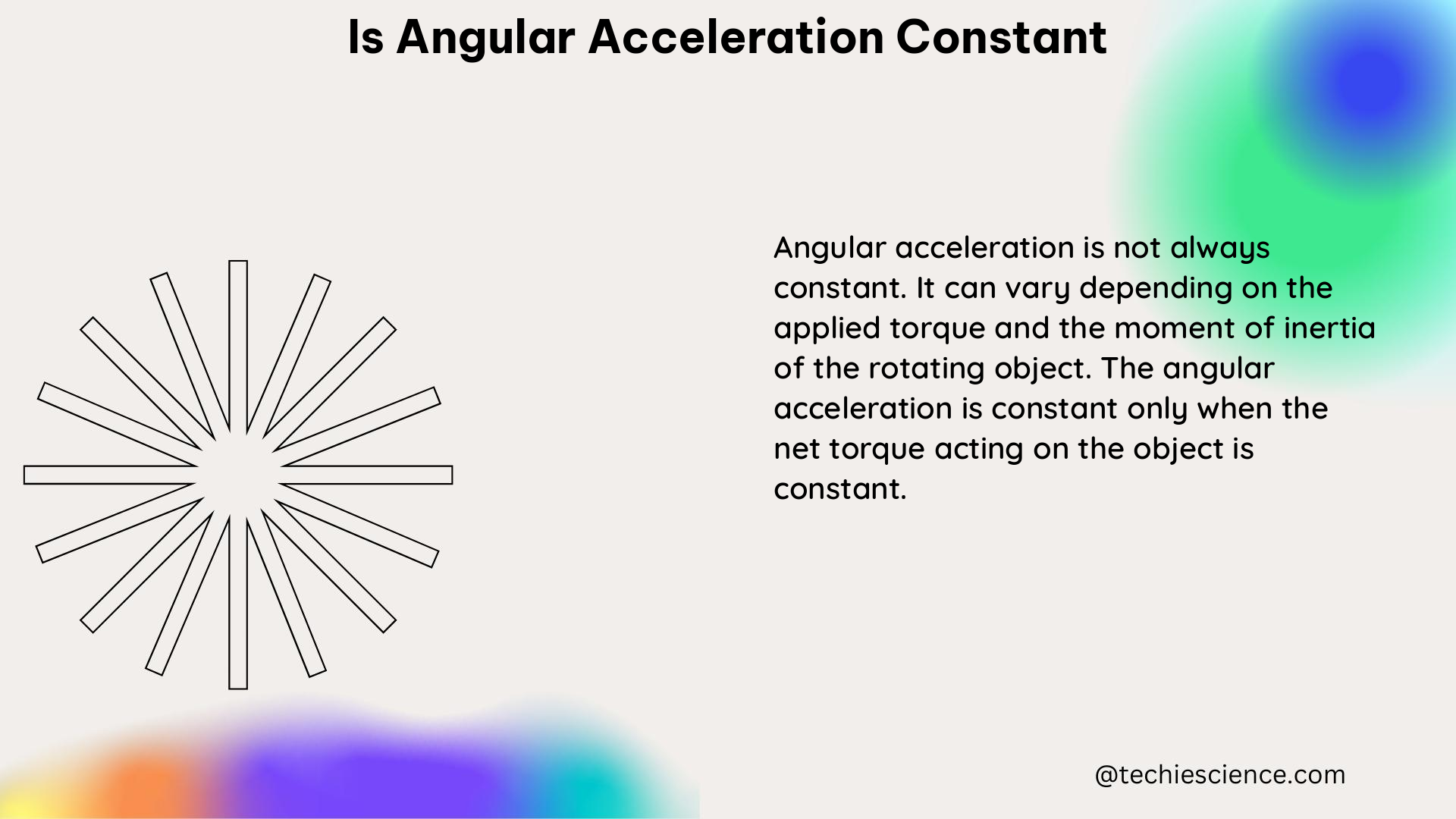Angular acceleration is a fundamental concept in rotational dynamics, and understanding whether it is constant or variable is crucial for analyzing the motion of rotating objects. This blog post will delve into the details of angular acceleration, providing a comprehensive guide on how to determine if it is constant or not.
Understanding Angular Acceleration
Angular acceleration, denoted by the symbol α, is a measure of the rate of change of an object’s angular velocity over time. It is a vector quantity, meaning it has both magnitude and direction, and is typically measured in radians per second squared (rad/s²) in the International System of Units (SI).
The formula for angular acceleration is:
α = Δω / Δt
Where:
– Δω is the change in angular velocity (in rad/s)
– Δt is the change in time (in s)
This equation tells us that angular acceleration is the rate of change of angular velocity with respect to time.
Constant Angular Acceleration

When the angular acceleration of an object is constant, it means that the rate of change of its angular velocity remains the same throughout the motion. In other words, the angular velocity increases or decreases at a constant rate.
To determine if the angular acceleration is constant, we can plot the angular velocity (ω) of the object against time (t). If the resulting graph is a straight line, then the angular acceleration is constant. The slope of this line represents the value of the constant angular acceleration.
The formula for constant angular acceleration is:
ω = ω₀ + αt
Where:
– ω is the final angular velocity (in rad/s)
– ω₀ is the initial angular velocity (in rad/s)
– α is the constant angular acceleration (in rad/s²)
– t is the time elapsed (in s)
This equation shows that the final angular velocity is the sum of the initial angular velocity and the product of the constant angular acceleration and the time elapsed.
Example 1: Constant Angular Acceleration of a Rotating Disc
Consider a rotating disc that changes its angular speed at a rate of 60 rad/s over a period of 10 seconds. To calculate the constant angular acceleration, we can use the formula:
α = Δω / Δt
α = 60 rad/s / 10 s
α = 6 rad/s²
This means that the angular acceleration of the disc is constant and equal to 6 rad/s².
Variable Angular Acceleration
In contrast to constant angular acceleration, variable angular acceleration occurs when the rate of change of an object’s angular velocity is not constant. This means that the angular acceleration changes over time.
To calculate the average angular acceleration over a given time interval, we can use the formula:
αavg = (ω₂ – ω₁) / (t₂ – t₁)
Where:
– αavg is the average angular acceleration (in rad/s²)
– ω₂ is the final angular velocity (in rad/s)
– ω₁ is the initial angular velocity (in rad/s)
– t₂ is the final time (in s)
– t₁ is the initial time (in s)
This equation tells us that the average angular acceleration is the change in angular velocity divided by the change in time.
Example 2: Variable Angular Acceleration of a Bicycle Wheel
Consider the rear wheel of a bicycle that has an angular acceleration of 20 rad/s². We can calculate the angular velocity of the wheel after 1 second using the formula:
ω = ω₀ + αt
ω = 0 + 20 rad/s² × 1 s
ω = 20 rad/s
This shows that the angular velocity of the wheel increases linearly with time, indicating a constant angular acceleration.
Factors Affecting Angular Acceleration
The angular acceleration of an object can be affected by various factors, including:
-
Applied Torque: The amount of torque applied to the object directly affects its angular acceleration. The greater the torque, the greater the angular acceleration.
-
Moment of Inertia: The moment of inertia of an object, which is a measure of its resistance to rotational motion, also influences its angular acceleration. Objects with a higher moment of inertia will have a lower angular acceleration for the same applied torque.
-
Mass Distribution: The distribution of an object’s mass can affect its angular acceleration. Objects with a more uniform mass distribution tend to have a higher moment of inertia and, consequently, a lower angular acceleration.
-
External Forces: Any external forces acting on the object, such as friction or air resistance, can also influence its angular acceleration.
Practical Applications of Angular Acceleration
Angular acceleration is a crucial concept in various fields, including:
-
Rotational Dynamics: Understanding angular acceleration is essential for analyzing the motion of rotating objects, such as wheels, gears, and rotating machinery.
-
Robotics and Automation: Angular acceleration is used in the design and control of robotic systems, where precise control of rotational motion is required.
-
Sports and Athletics: Angular acceleration is important in sports that involve rotational motion, such as gymnastics, figure skating, and certain throwing events.
-
Aerospace Engineering: Angular acceleration is a key factor in the design and control of spacecraft, satellites, and other aerospace vehicles.
-
Mechanical Engineering: Angular acceleration is used in the design and analysis of rotating machinery, such as engines, turbines, and generators.
Conclusion
In summary, angular acceleration can be either constant or variable, and understanding the difference is crucial for analyzing the motion of rotating objects. By measuring the angular velocity of an object at different points in time and calculating the rate of change, we can determine whether the angular acceleration is constant or variable. This knowledge is essential in various fields, from rotational dynamics to robotics and aerospace engineering.
References:
- Angular Acceleration – Physics Classroom
- Rotational Kinematics – Khan Academy
- Rotational Motion – HyperPhysics

Hi,
I am Megha B R, I have completed my Post-Graduation in Solid State Physics and pursuing B. Ed. I am a Physics enthusiast. As an Academic writer, my goal is to reach the readers in a simplified manner through my articles.
Let’s connect through LinkedIn-